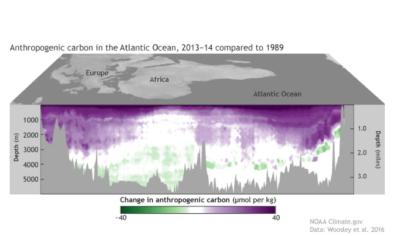Science Source
Detecting regional anthropogenic trends in ocean acidification against natural variability
- States that about 30 percent of the ~500 billion metric tons of carbon released to the atmosphere through fossil fuel burning, cement production and land use has been taken up by the oceans
- States that the oceanic uptake of carbon dioxide leads to changes in marine carbonate chemistry resulting in a decrease of seawater pH and carbonate ion concentration, commonly referred to as ocean acidification
- States that ocean observations are severely limited with respect to providing reliable estimates of the signal-to-noise ratio of human-induced trends in carbonate chemistry against natural factors
- Uses three Earth system models to show that the current anthropogenic trend in ocean acidification already exceeds the level of natural variability by up to 30 times on regional scales
- Demonstrates that the current rates of ocean acidification at monitoring sites in the Atlantic and Pacific oceans exceed those experienced during the last glacial termination by two orders of magnitude
Related Content
Headline

Jun 6, 2018 | NOAA Climate.gov
Cruises cut a slice through the Atlantic's carbon pie
Science Source
| Biogeosciences
Using present-day observations to detect when anthropogenic change forces surface ocean carbonate chemistry outside preindustrial bounds
Sutton, Adrienne J., Sabine et al
Science Source
| Estuaries and Coasts
Is Ocean Acidification an Open-Ocean Syndrome? Understanding Anthropogenic Impacts on Seawater pH
Carlos M. Duarte, Iris E. Hendriks, Tommy S. Moore et al
Science Source
| Proceedings of the National Academy of Sciences
Ocean acidification affects coral growth by reducing skeletal density
Nathaniel R. Mollica, Weifu Guo, Anne L. Cohen et al


